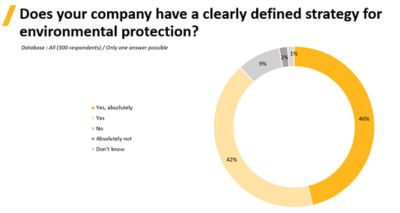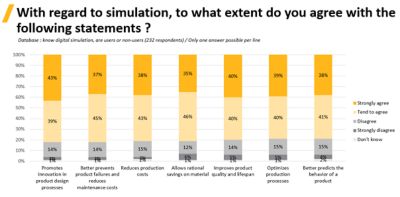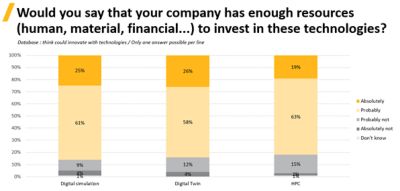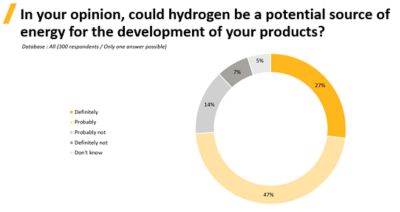-
-
学生向け無料ソフトウェアにアクセス
Ansysは次世代の技術者を支援します
学生は、世界クラスのシミュレーションソフトウェアに無料でアクセスできます。
-
今すぐAnsysに接続!
未来をデザインする
Ansysに接続して、シミュレーションが次のブレークスルーにどのように貢献できるかを確認してください。
国および地域
無料トライアル
製品およびサービス
リソースとトレーニング
当社について
Back
製品およびサービス
Ansysブログ
January 11, 2024
シミュレーションが持続可能性に与える影響に関するフランス企業を対象とした調査
地球規模で起きている気候変動の最大の原因は、私たちの生活や日常的に使う製品によって排出された温室効果ガスです。パリ協定で採択されたように、世界のカーボンフットプリントをより安全なレベルまで削減するための持続可能なソリューションを開発することが私たちの責任です。一方で、企業は新製品をより迅速かつ低コストで市場に投入する必要に迫られています。しかし、いち早く製品を市場に投入することは、製品が持続可能であることを保証する慎重なステップとは相反するように見えます。
Ansysのエンジニアリングシミュレーションを活用すると、1つの物理的なプロトタイプを作製してテストするのと同じ所要時間で、数百のデジタルプロトタイプをコンピュータ上で仮想的に作製してテストでき、ニーズに合わせた迅速なペースで持続可能な製品を開発できるようになります。さらに、ハイパフォーマンスコンピューティング(HPC)とデジタルツインを採用することで、開発時間をさらに短縮し、製品の動作を簡単に監視して、高レベルのエネルギー効率を確保できるようになります。
こうしたメリットは、エンジニアがシミュレーションソフトウェア、HPC、デジタルツインの重要性を認識して正しく活用している場合にのみ得られます。このような最新テクノロジーがどの程度採用されているかを把握するために、InfoPro Digital社に依頼して、フランス国内の企業300社を対象に、製品開発に関する調査を実施しました。この調査結果の一部をご紹介します。

環境への取り組み
今回の調査では、対象企業300社のうち88%が環境保護のために明確な戦略を立てていることがわかりました。そして、77%が自社製品の環境への影響が自社にとって優先事項であると回答しています。これらの数字から、環境への取り組みに対する高い関心は見られるものの、まだ改善の余地があることがわかりました。

環境問題への対処方法の1つとして、製品のライフサイクルを通じた材料データの管理があります。調査では、以下のことがわかりました。
- 対象企業の40%が、製品の材料を選択する際に、リサイクルまたはアップサイクルの可能性を確実に考慮すると回答しました。
- 45%が、リサイクルやアップサイクルを場合によっては考慮すると回答しました。
- 82%が、製品の材料の持続可能性に関する調査を実施していると回答しました。
このように、これらの企業にとっては、持続可能性は明らかに優先事項となっています。しかし一方で、回答者の58%が、製品に使用する信頼できる材料特性情報を見つけるのに苦労していると答えています。この問題は、700を超える材料とその特性を備え、コンピュータ支援設計(CAD)およびシミュレーションソフトウェアですぐに使用できるインテリジェントな材料データベースであるAnsys Granta MIを導入することで解決できます。Granta MIは、社内全体で材料特性の信頼できる唯一の情報源となることで、すべてのエンジニアが同じ材料データにアクセスできるようになります。また、開発した独自材料の特性もデータベースに追加してアクセスすることが可能です。
シミュレーション、HPC、デジタルツインの認識と活用
回答者の大半は、デジタルシミュレーション、HPC、デジタルツインを認識しており、多くの回答者が活用していると答えています。しかし、以下の表に示すように、3分の1以上の回答者がデジタルツインテクノロジー(38%)あるいはHPC(36%)を知らないと回答しました。

これは、企業がシミュレーション、HPC、デジタルツインを広く導入して、製品やプロセスのデジタルフットプリントを改善する大きな余地があることを示しています。シミュレーションを導入しているかどうかにかかわらず、多くの回答者はエンジニアリングシミュレーションの価値を以下のように認識しています。
- 82%が、シミュレーションによって製品設計プロセスのイノベーションが促進されることを認識しています。
- 82%が、シミュレーションを導入することで製品の故障を防止でき、メンテナンスコストを削減できると回答しています。
- 81%が、シミュレーションによって生産コストの削減が可能であると回答しています。
- 81%が、シミュレーションを導入することで材料を節約できると回答しています。
- 80%が、シミュレーションを導入することで製品の品質と寿命が向上すると回答しています。
- 79%が、シミュレーションを導入することで生産プロセスを最適化できると回答しています。
- 79%が、シミュレーションを導入することで製品の挙動をより良く予測できると回答しています。

HPCとデジタルツインについては、以下のAnsysソリューションを活用できます。
- Ansys HPCを使用すると、マルチコアコンピュータを使用して、より少ない時間でより多くのシミュレーションを実行できます。HPCを使用することで、これまで以上に大規模で複雑なシミュレーションを、より高い精度で実行できます。各種のAnsys HPCライセンスオプションにより、シングルユーザーまたは少人数ユーザーグループによるエントリーレベルの並列処理から、実質的に無制限の並列処理能力まで、シミュレーションのニーズに応じた計算レベルを選ぶことが可能です。
- Ansys Twin Builderを使用すると、実際のシステムの完全な仮想プロトタイプを実装できます。これらは、製品とアセットのライフサイクル全体を管理するために展開できます。このデジタルツインシミュレーションパラダイムにより、時間の経過とともに効率を飛躍的に向上させ、現実世界のテストと応答でより正確になる予測手法に基づいてメンテナンスをスケジュールすることができます。この情報にアクセスすることで、エンジニアは既存の資産からさらなる価値を引き出すことができます。これにより、予期しないダウンタイムを防ぎ、運用コストを削減しながら、最適な効率で作業し、すべてがあらゆるモノのインターネット(IoT)プラットフォームで行われます。
こうした最先端テクノロジーを今後導入する可能性があると回答した企業の大半は、それらに投資する適切な手段があると回答しています。

イノベーションの未来
今回の調査では、水素と原子力の2つの代替エネルギーに関する質問も実施しました。
回答者の70%が、将来は水素がエネルギー源として広く採用されるだろうと回答しました。「水素は自社製品を開発する際のエネルギー源になり得るか」という質問に対して、回答者の74%が「なる」または「可能性はある」と答えました。

そのうちの82%が、水素エネルギーを導入するために必要なすべてのツールを自社で所有していると回答しています。
原子力については、74%が原子力を活用してカーボンニュートラルを達成できるであろうと回答しました。
どのようなエネルギー源やテクノロジー(風力、太陽光、持続可能な航空燃料、地熱、原子力、水素、バイオ燃料、バッテリ、二酸化炭素回収など)を使用しているかにかかわらず、多くの回答者はエンジニアリングシミュレーションが製品やプロセスの設計にもたらす価値を認識していました。シミュレーション、HPC、デジタルツインテクノロジーについて、まだ知識がないのであれば、今こそがそのメリットについて学ぶ絶好の機会です。地球の未来のために、温室効果ガスの排出を削減して地球規模の気候変動を緩和できるように、私たち全員が最良のツールを採用することが必須となるでしょう。
Simulation 4.0によって拓かれる持続可能な開発への道については、「シミュレーション4.0と業界の転換 – 持続可能な開発への道」をご覧ください。このウェビナーでは、以下のトピックスを取り上げます。
- 持続可能な開発という観点からの業界転換の課題
- エンジニアリングシミュレーションや、HPCおよびデジタルツインなどの最先端テクノロジーが果たす役割
- 製造業界の将来の課題